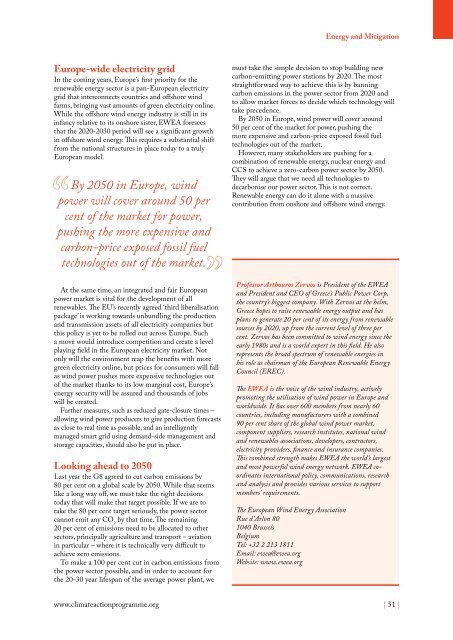Climate Action 2010-2011
Create successful ePaper yourself
Turn your PDF publications into a flip-book with our unique Google optimized e-Paper software.
Energy and Mitigation<br />
Europe-wide electricity grid<br />
In the coming years, Europe’s first priority for the<br />
renewable energy sector is a pan-European electricity<br />
grid that interconnects countries and offshore wind<br />
farms, bringing vast amounts of green electricity online.<br />
While the offshore wind energy industry is still in its<br />
infancy relative to its onshore sister, EWEA foresees<br />
that the 2020-2030 period will see a significant growth<br />
in offshore wind energy. This requires a substantial shift<br />
from the national structures in place today to a truly<br />
European model.<br />
By 2050 in Europe, wind<br />
power will cover around 50 per<br />
cent of the market for power,<br />
pushing the more expensive and<br />
carbon-price exposed fossil fuel<br />
technologies out of the market.<br />
At the same time, an integrated and fair European<br />
power market is vital for the development of all<br />
renewables. The EU’s recently agreed ‘third liberalisation<br />
package’ is working towards unbundling the production<br />
and transmission assets of all electricity companies but<br />
this policy is yet to be rolled out across Europe. Such<br />
a move would introduce competition and create a level<br />
playing field in the European electricity market. Not<br />
only will the environment reap the benefits with more<br />
green electricity online, but prices for consumers will fall<br />
as wind power pushes more expensive technologies out<br />
of the market thanks to its low marginal cost, Europe’s<br />
energy security will be assured and thousands of jobs<br />
will be created.<br />
Further measures, such as reduced gate-closure times –<br />
allowing wind power producers to give production forecasts<br />
as close to real time as possible, and an intelligently<br />
managed smart grid using demand-side management and<br />
storage capacities, should also be put in place.<br />
Looking ahead to 2050<br />
Last year the G8 agreed to cut carbon emissions by<br />
80 per cent on a global scale by 2050. While that seems<br />
like a long way off, we must take the right decisions<br />
today that will make that target possible. If we are to<br />
take the 80 per cent target seriously, the power sector<br />
cannot emit any CO 2<br />
by that time. The remaining<br />
20 per cent of emissions need to be allocated to other<br />
sectors, principally agriculture and transport – aviation<br />
in particular – where it is technically very difficult to<br />
achieve zero emissions.<br />
To make a 100 per cent cut in carbon emissions from<br />
the power sector possible, and in order to account for<br />
the 20-30 year lifespan of the average power plant, we<br />
must take the simple decision to stop building new<br />
carbon-emitting power stations by 2020. The most<br />
straightforward way to achieve this is by banning<br />
carbon emissions in the power sector from 2020 and<br />
to allow market forces to decide which technology will<br />
take precedence.<br />
By 2050 in Europe, wind power will cover around<br />
50 per cent of the market for power, pushing the<br />
more expensive and carbon-price exposed fossil fuel<br />
technologies out of the market.<br />
However, many stakeholders are pushing for a<br />
combination of renewable energy, nuclear energy and<br />
CCS to achieve a zero-carbon power sector by 2050.<br />
They will argue that we need all technologies to<br />
decarbonise our power sector. This is not correct.<br />
Renewable energy can do it alone with a massive<br />
contribution from onshore and offshore wind energy.<br />
Professor Arthouros Zervos is President of the EWEA<br />
and President and CEO of Greece’s Public Power Corp,<br />
the country’s biggest company. With Zervos at the helm,<br />
Greece hopes to raise renewable energy output and has<br />
plans to generate 20 per cent of its energy from renewable<br />
sources by 2020, up from the current level of three per<br />
cent. Zervos has been committed to wind energy since the<br />
early 1980s and is a world expert in this field. He also<br />
represents the broad spectrum of renewable energies in<br />
his role as chairman of the European Renewable Energy<br />
Council (EREC).<br />
The EWEA is the voice of the wind industry, actively<br />
promoting the utilisation of wind power in Europe and<br />
worldwide. It has over 600 members from nearly 60<br />
countries, including manufacturers with a combined<br />
90 per cent share of the global wind power market,<br />
component suppliers, research institutes, national wind<br />
and renewables associations, developers, contractors,<br />
electricity providers, finance and insurance companies.<br />
This combined strength makes EWEA the world’s largest<br />
and most powerful wind energy network. EWEA coordinates<br />
international policy, communications, research<br />
and analysis and provides various services to support<br />
members’ requirements.<br />
The European Wind Energy Association<br />
Rue d’Arlon 80<br />
1040 Brussels<br />
Belgium<br />
Tel: +32 2 213 1811<br />
Email: ewea@ewea.org<br />
Website: www.ewea.org<br />
www.climateactionprogramme.org | 51 |












